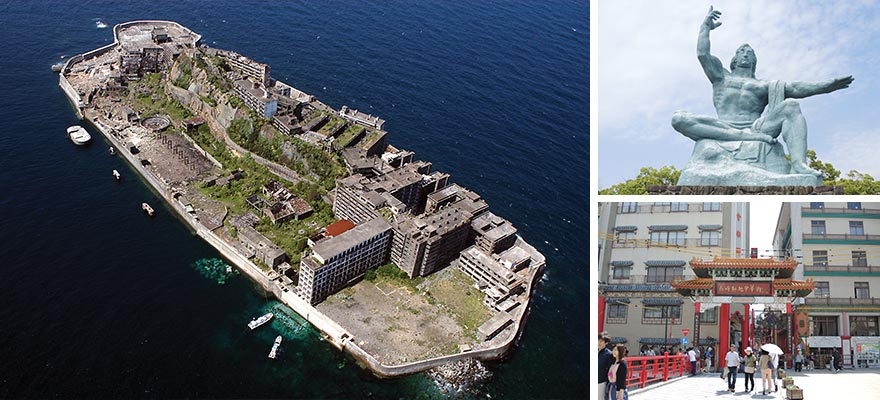Home > Highlighting JAPAN >Highlighting Japan June 2014> 47 Prefectures from A to Y
Highlighting JAPAN
47 Prefectures from A to Y
Nagasaki
Nagasaki City and Battleship Island

The capital of Nagasaki Prefecture on the island of Kyushu, Nagasaki City has long been a bridge for foreign trade and relations with both Asia and Europe. The city's architecture reflects its colorful past, notably Oura Catholic Church, built at the end of the Edo Period for the city's burgeoning community of foreign traders who had gravitated to the city during Japan's era of isolation. Oura and Nagasaki's other elegant churches are juxtaposed with wonderfully preserved examples of classical Chinese architecture, such as the Buddhist temples Sofukuji and Kofukuji, creating an exotic atmosphere.
Visitors to Nagasaki will enjoy an afternoon strolling through Oranda-Zaka ("Dutch Slope") where Western merchants once resided, taking in the greenery of Nagasaki Peace Park and later sampling authentic delights while exploring bustling Chinatown. After dark, find a spot to view Nagasaki's nightscape, which is said to equal those of Monaco and Hong Kong.
Just a short distance away from the city itself, 19 kilometers away from Nagasaki Port, is the abandoned island of Hashima. Also known as Gunkanjima, meaning "Battleship Island," Hashima has drawn tourists in large numbers in recent years. It earned its nickname from the protective embankment around the island's 1,200-meter perimeter, reinforced concrete tower blocks and lofty chimneys.
The tiny island has a surface area of only around 63,000 square meters, and originally became famous as a coalmine producing high-quality coal. The mine remained in operation for 85 years until its closure in 1974.
Hashima was a small, steep sandstone rock, thought to have been just 320 meters from north to south and 100 meters from east to west. As coal extraction intensified, however, Hashima underwent landfill construction on six occasions to cope with the increasing demand for living space, reaching its current size in 1931.
Dwellings had to expand upward as more and more workers flocked from far and wide to take advantage of the favorable wages. Like a huge, crowded passenger vessel moored off the Nagasaki coast, Hashima boasted sophisticated tunnels and walkways, cutting-edge concrete dwellings, a dance hall and bar, and a school, temple, market and vegetable garden. Workers and their families, were living in an area nine times more densely populated than modern-day Tokyo.
The miners toiled in 30-degree heat and 95 percent humidity to mine millions of tons of coal, extracting 411,100 tons in 1941 alone. Most of that output was sent to the Yahata Ironworks in Kyushu. Hashima's coal was of the highest quality, low in ash and sulfur, and it was also easily pulverized. As coal was abandoned for other more economical forms of energy, the mine was eventually closed. Although long since deserted, Hashima's desolation and visible decrepitude lure hundreds of thousands of tourists each year. Japan has recently proposed that the island be designated a UNESCO World Heritage site in recognition of the crucial role it played in the country's drive to industrialization. Besides symbolizing a key era in Japan's modern history, Hashima was a dynamo that presaged the global economic power the small island nation would one day become.
© 2009 Cabinet Office, Government of Japan






